 |
SRGC Feature Article |
| Home Recommend This Site To A Friend |
|
Gardens have always been a magnet for insects of all kinds, and in this article I am going to deal with butterflies. The original 'butter-coloured fly' is the Brimstone butterfly (Gonepteryx rhamni), the harbinger on an English spring, but alas not found in Scotland. It feeds on buckthorn (both Rhamnus catharticus and Frangula alnus) as a caterpillar and these plants are not native to Scotland. It hibernates as an adult and is the first butterfly to appear, often on warm February days, from its winter quarters amongst ivy leaves. Roy Lancaster, in a BBC Gardener's Question Time broadcast from Dunblane, suggested we plant buckthorn in our hedges to attract Brimstones. I have and I'm ready and waiting! In Scotland, we have a few dozen butterflies, and many can be found in our gardens if we have the correct plants. Only if you have a large garden with a meadow and large clumps of nettles, and an area of short turf will you expect to see anything other than the common species. If you live near woodland, or the coast, you may see unusual species like the purple hairstreak (Quercusia quercus) and the small blue (Cupido minimus) respectively. We are, however, mostly dependent on species coming into the garden that are travellers or have wandered in from the surrounding countryside. We therefore have to attract them with the appropriate nectar plants, such as aubrieta, buddleia, thyme, Michaelmas daisies, Sedum spectabile (especially in its form 'Brilliant'), phlox and many others. The species. I will start with winter. Two species of butterfly over winter as adults in our sheds, garages, outhouses and other buildings. They are the peacock (Inachis io) and the small tortoiseshell (Aglais urticae). 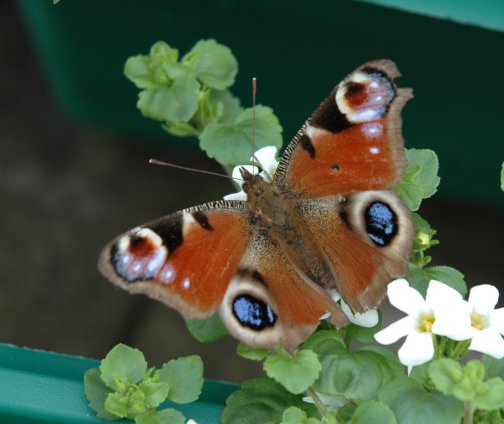 Peacock butterfly basking on bedding plants, photographed at a garden centre, May 2004. 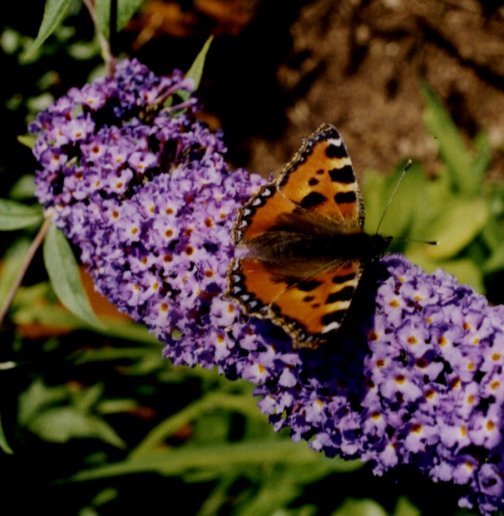 Small tortoiseshell on phlox May 2004. The tatty nature of the above butterflies is due to the length of time they have been on the wing. Both species lay their eggs in May or June on stinging nettles. Not the odd weed in the garden, but on plants growing in a large clump is full sun. They lay their eggs in a batch on the underside of a leaf. The larvae are gregarious and until fully grown live in a tent-like web. The adults emerge in July and are on the wing until August or September, when they find a suitable place, often under the roof of a shed or garage, to hibernate. Ten years ago the peacock was a coastal species in Scotland. It is now one of the commonest late summer butterflies, certainly in Dunblane, and this year I saw them in numbers in the spring throughout central Scotland for the first time. 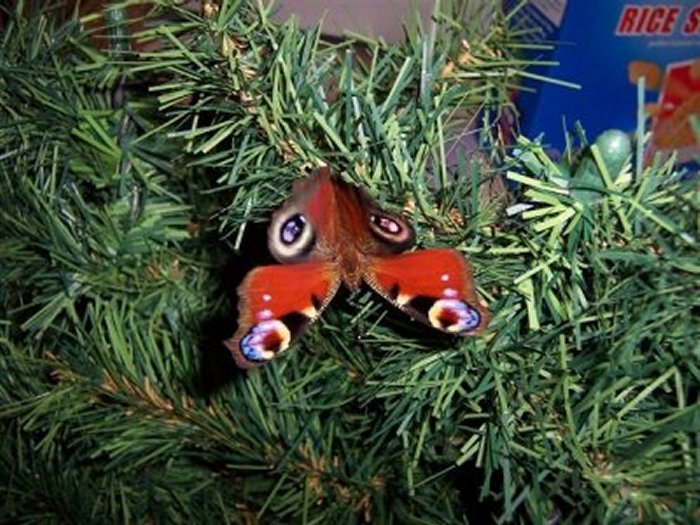 Peacock in garden shed This picture of a peacock butterfly was taken in early December 2003, when the photographer was looking in the shed for the artificial Christmas tree. The butterfly opens its wings with a loud hiss, flashing its eye spots. This is a defensive mechanism, more effective when the butterflies hibernate in numbers. The plan is, if it makes that much noise and has four eyes that big, how big is its body? The first warms days of March awakens these butterflies from their slumbers, and shed and garage windows need to be checked to see if a butterfly needs to be released. As we move into April, butterflies that spend the winter as pupae (chrysalides) emerge. The first is the small white (Pieris rapae), which gardeners often regard as a pest. 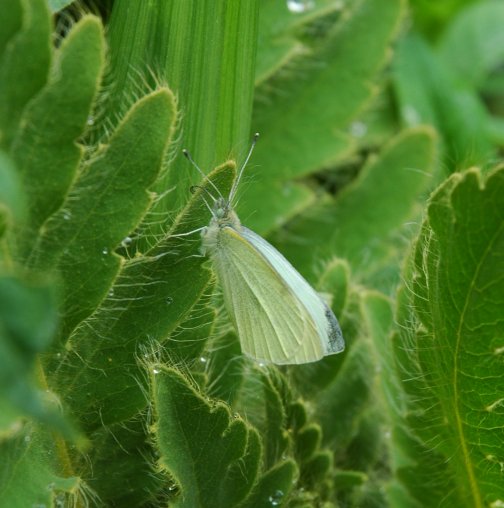 Male small white which spent a couple of dull days resting on this mecanopsis. Note the proboscis drinking water droplets produced by a passing shower of rain. The larvae feed on crucifers, such as cabbage and mustard. They are solitary and green in colour. There are two broods, with a more boldly patterned summer brood in July. Shortly after the small white makes its appearance, the very similar green veined white (Artogeia napi) can be seen. The larvae feed on various crucifers, but not cabbages. Lady's smock (Cardamine pratense) is a favoured plant. I have seen females lay on aubrieta, but have never found caterpillars on that plant. Lowland forms are double brooded, but an upland form, called Artogeia napi thomsoni, named after the eminent lepidopterist George Thomson is only single brooded, appearing in June. George doesn't fit the norm for famous scientists, being still alive. 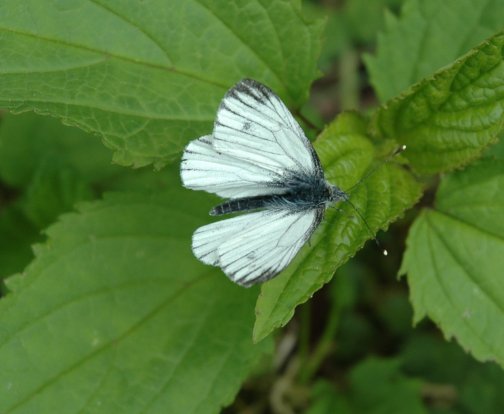 Male green veined white in a polytunnel at a nursery near Dunblane, May 2004. 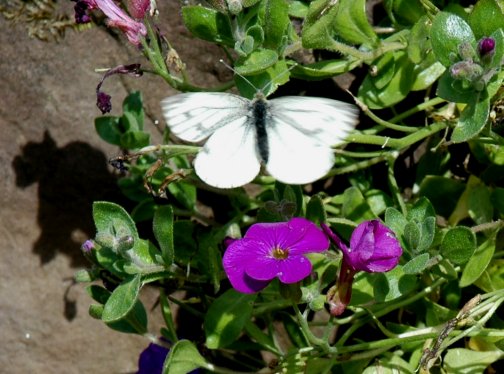 Female green veined white taking off from an aubrieta plant in my garden in Dunblane, where it had just laid a solitary egg. One butterfly which symbolises the springtime is the orange tip (Anthocaris cardamines). 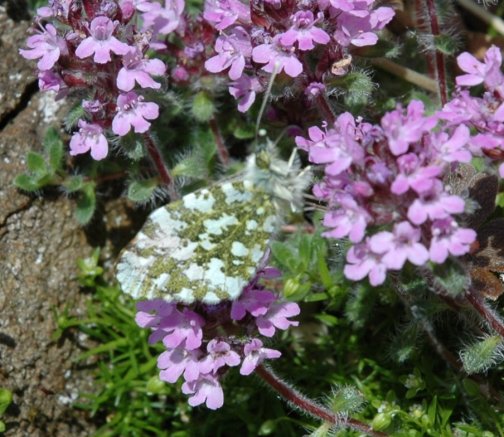 Male orange tip feeding on thyme, May 2004. Note the dappled pattern giving superb camouflage. Even the 'orange tip' is hidden. Until the early 1980s, it had a bimodal distribution in Scotland: Kingussie northwards and Ayrshire southwards. The distribution of the food plants, lady's smock and Jack-by-the-hedge (Alliaria petiolata), haven't changed, so it must be global warming that has caused the rapid colonisation of central Scotland. 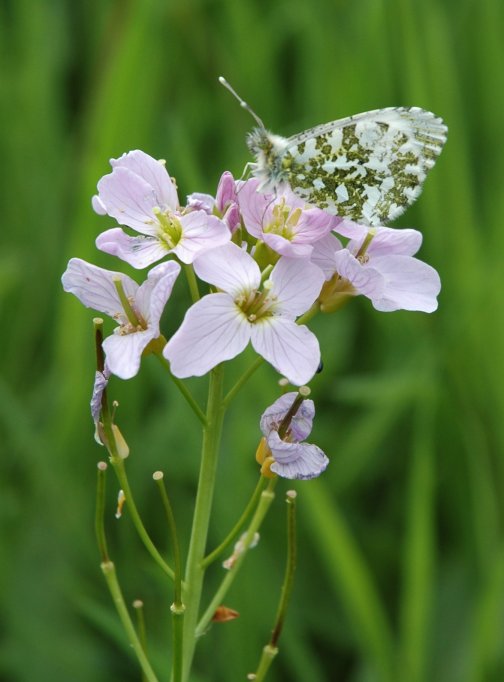 Female orange tip on lady's smock. 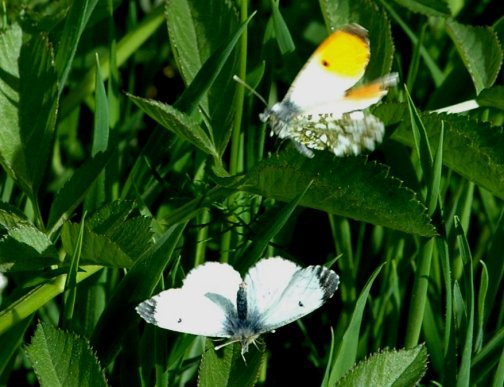 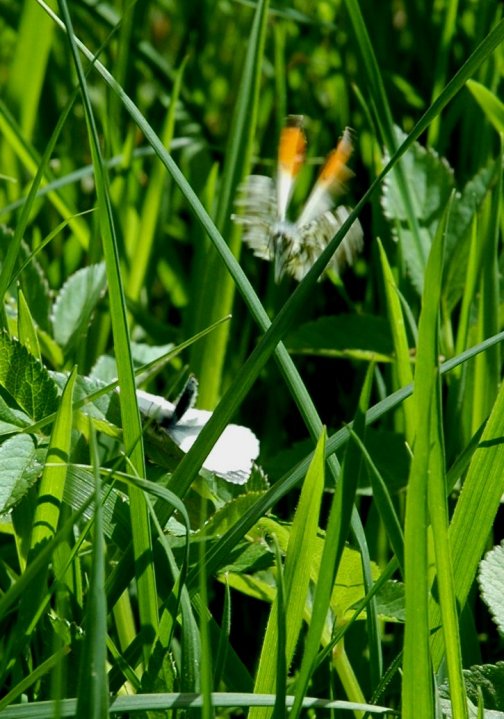 Orange tips courtship flight Orange tips rarely rest with their wings open, so the following pictures show a female rebuffing the attentions of an amorous male! He showers her with scent scales from his forewings and she raises her abdomen to show she has already mated. The eggs are laid singly, and if two caterpillars meet, one invariably eats the other. This ensures enough food for the victor. Early summer also sees the arrival of some migrants, such as the red admiral (Vanessa atalanta). This butterfly, whose larvae also feed on nettles, is a southern European species that only breeds in Scotland during the summer. Buddleia bushes attract them in fair numbers in August and September. 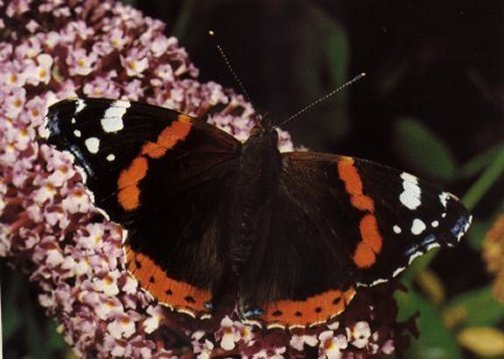 Red admiral on buddleia (Buddleja davidii). More common recently is the painted lady (Vanessa cardui), and last year one visited my garden in May. 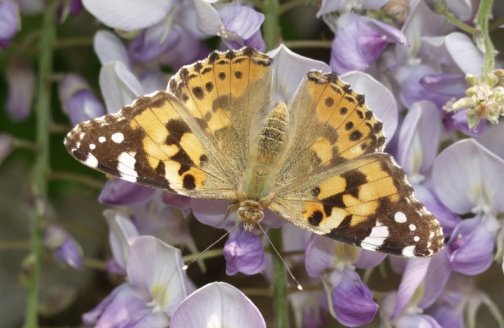 Painted lady on wisteria, May 2003. It wasn't feeding as the proboscis was not extended. As the name suggests, the larvae feed on thistle (Carduus spp.) but can also be found on nettles. It is more often seen in the late summer, when the second or third brood has emerged and spread north. This is also when the small tortoiseshells and peacocks are most abundant. Both the red admiral and the painted lady caterpillars lead solitary existences, and wrap themselves in a small tent near the top of the food plant. 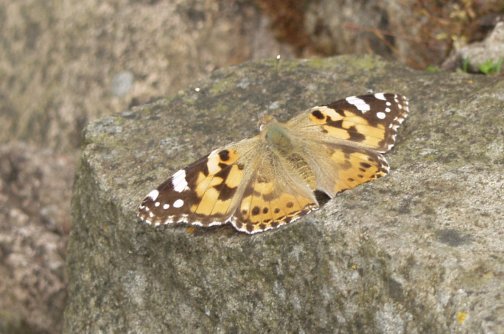 Painted lady basking on a rock, late summer 2003. 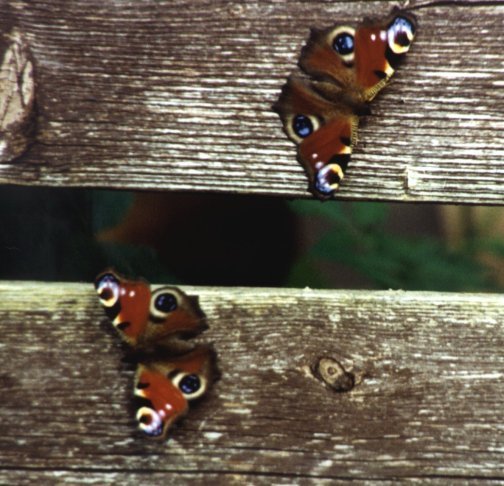 Peacocks on the compost bin.  Small tortoiseshell on the buddleia. The small tortoiseshell has declined in numbers recently and the reason is a mystery. One butterfly that has the best of both worlds is the large white (Pieris brassicae) as it over winters as a pupa and is also migratory. This pest of cabbages appears in May and is supplemented by waves of migrants from the continent. It is also double brooded, with a much commoner, and more heavily marked second brood in July. 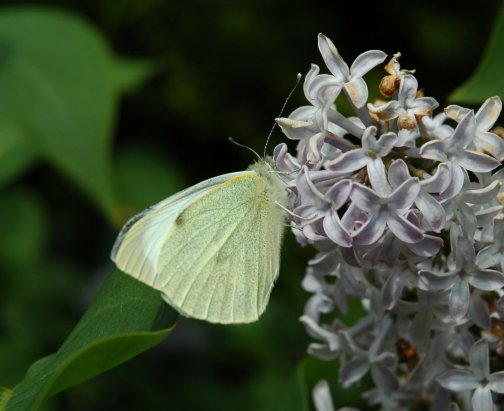 Male large white having a pit stop at the lilac filling station, May 2004. The larvae are pests on cabbages and nasturtiums. They are gregarious and distasteful. To emphasise the point, they are black and yellow, classic evolutionary warning colours, and they emit a terrible smell. You may be lucky and see other butterflies in your garden, such as the ringlet (Aphantopus hyperantus). This species has also increased its range in recent years. The eggs are laid by randomly from the air over rough grassland and the larvae are grass feeders. This food plant is also shared with other butterflies of the Satyridae (browns) family. 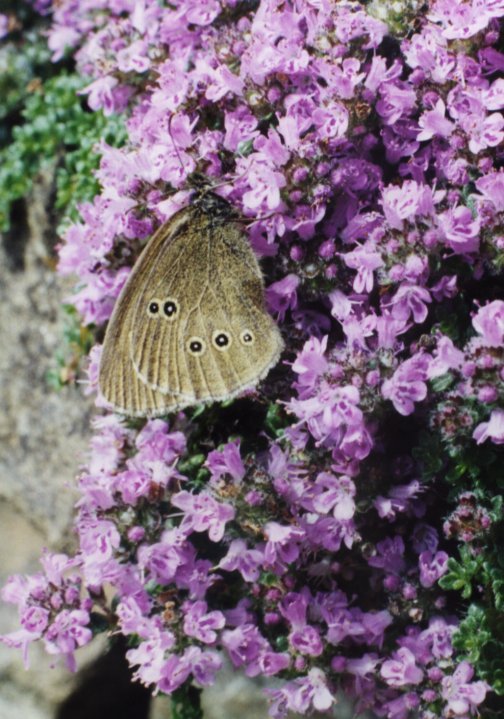 Ringlet One pest foreign imported species that has made an appearance in garden centres is the South African geranium bronze (Cacyreus marshalii). 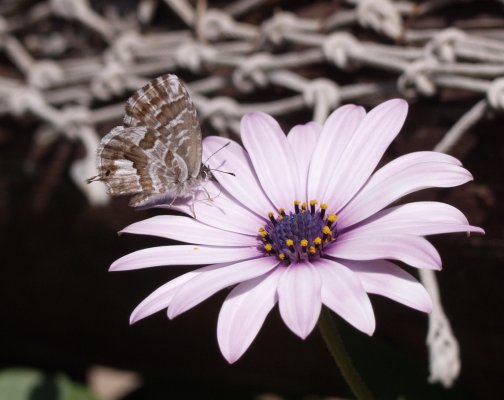 Geranium bronze This one was photographed in Benidorm, Spain in April 2004, but has been found in many places in England in the last year or two. It has become a pest of zonal pelargoniums in southern Europe since the late 1980s. With global warming, who knows what may spread north. The comma (Polygonia c-album), once confined to Herefordshire, where hurricanes hardly ever happen, and now is found near Durham. It is another nettle feeder and over winters in hedges where it resmbles a dead leaf. Perhaps one day, species found commonly on the continent, will spread north? One such species, the black veined white (Aporia crataegi), became extinct in England in the 1920s, and it feeds on hawthorn, a common hedgerow plant. 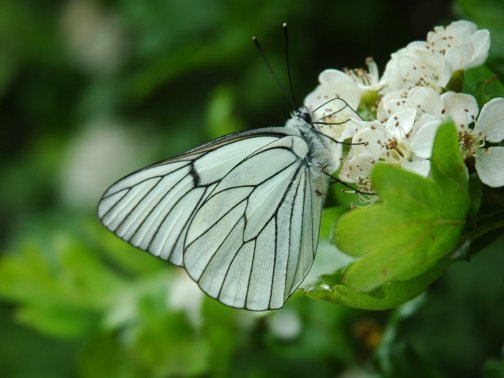 Black veined white on hawthorn June 2004. This is a French butterfly, but one day it may be found in Scotland!? ^ back to the top ^ |